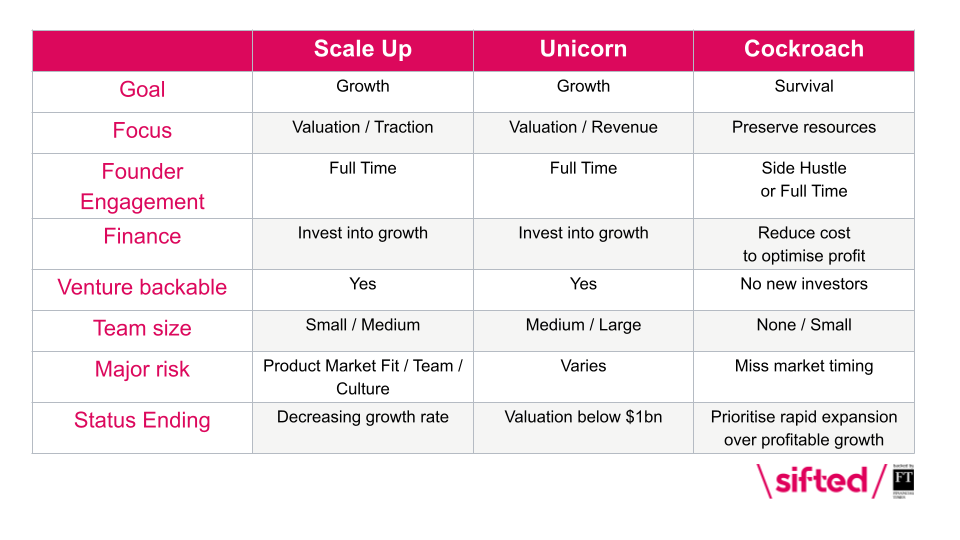Startup success has become synonymous with unicorn breeding. We’re obsessed with stories of rapid success, scaling, and all numbers going up and to the right — and then some.
But slow, incremental progress is just as valid a path as hypergrowth — though it might not be as exciting as a rocket symbol, nor as magical as a unicorn. It comes with its own totem: the cockroach. It’s an animal that more founders should know on their emoji keyboard.
Why are cockroaches important now?
Cockroach companies aren’t glamorous, aspirational or exciting. But they are bloody great at surviving. Dave McClure, founder of 500 Startups, is credited with coining the term in 2013 to describe resilient companies that optimise for sustainable, steady growth. Like its namesake, the term lived on to grow in the shadows, popped up here and there, and generally survived without making many headlines.

Rapid growth isn’t an option for many founders. The world doesn’t care about our pitch decks and market aspirations when shit happens. 71% of startups worldwide have cut costs during the pandemic, reports the Startup Genome’s Global Startup Ecosystem Report 2020. Of those that survived, only 10% expect their revenue to grow by a lot.
It’s reasonable to assume that we’ll experience shocks similar to the pandemic in the future. And before that, founders will be busy putting out other fires. Adding fuel to everything isn’t always the best solution or even a viable one.
Rapid growth isn’t an option for many founders. The world doesn’t care about our pitch decks and market aspirations when shit happens.
Although there are over 800 successful unicorn companies worldwide, they don't represent a realistic outcome for the vast majority of startups. Even before Covid-19, over 90% of entrepreneurial businesses in Europe failed by various measures. Most of those that stay in business tend to stay small; 93.5% of the EU’s 22.6 million small to medium enterprises (SMEs) have less than 10 employees. It’s time to rethink our perception of what makes a successful business and what methods of growth — including cockroach mode — are available to founders. That includes having the right vocabulary.
When does cockroach mode make sense?
There are times where slowing down makes sense. Most notably, if you run out of cash — but smart founders can also switch in and out of cockroach mode intentionally with a proactive, long-term outlook.
The ideal cockroach path includes profit from the beginning. Being profitable from the start with a lean, low-cost operation gives founders the freedom to grow at their own pace and terms before inviting external investors in.
SurveyMonkey is a great example. The founding team valued work-life balance more than rapid growth and focused on a steady, profitable trajectory. Small but reliable profits allowed it to survive during the dotcom crash when others failed, all while preserving its culture and shielding its team from the fallout.
Where profits aren’t there yet, being in cockroach mode can also help entrepreneurs stretch their resources. Case in point: GitHub’s founders grew their startup as a side hustle. They sustained the company’s life with personal income from side jobs until their startup was able to sustain its founders.
And sometimes it’s just good to scale down. In fact, that’s what most entrepreneurs did in 2020. Our UK-based startup Droplet focuses on sports clubs and launched its Beta in March 2020. Bad timing. A year later we’ve decided to reduce our team and speed, maintain growth at minimum expense and retain our existing customers to grow slowly until the pandemic is truly over and we’re ready to give it another go.
How to be a good cockroach
Being a cockroach isn’t easy. Competitors can swoop in and win significant market share if the company doesn’t adapt to changing customer needs quickly enough. But here are a few tips to survive:
1/ Have a plan
Cockroach mode is not the same as playing dead. You still need a goal and a way to get there. But having less time, people and money means your goals need to scale down too. If you’re not focused on growth, maybe invest only in retention for now. If you have no customers yet, maybe optimising your website and SEO is enough to analyse what product-market fit looks like on the demand side. If you can’t spend money on hiring a team, figure out what a part-time arrangement, gig work or favours could look like. And if you’re exhausted from moonlighting next to your day job, put less pressure on your startup. Surviving doesn’t take much, but a plan helps.
2/ Give it time
What happens if your business survives for five years with zero growth? Unless you’re in an emerging and fast-changing technology like space tourism or artificial food, then the likely answer is: not much. You’d be in the same position you’re in now, except with five years more knowledge about your customers, market and product. Third-party SaaS that makes life easier for founders will have developed further as well. Your network will have grown too, and customers will know you better. Your brand may even grow a little further via customer referrals and Google bots crawling your website. So you’ll know more, have better tools, a stronger network, better branding and can pick up where you are now. What could possibly be the worst thing that happens if you scale down or even pressed the pause button for a year, or two or five?
3/ Tell everyone
Admitting to yourself that you’re off the unicorn bandwagon is hard. Especially if you’ve just spent the last few months PowerPoint-ing your way through the VC community. Admitting it to the world can be even harder. There is the temptation to scale down internally and externally, retain a professional, 'busy' front. That is not sustainable for your business. And it's potentially harmful to your mental state if you’re running two versions of your startup at once. Being on the same page with your customers, partners, team, family, friends and neighbours makes life easier for you. It also means most likely a ton of supportive empathy. We’ve received more good wishes when we announced our cockroach mode from customers, friends, investors, partners and strangers than we got in reply to our Christmas cards.
4/ Protect your relationships
If you have investors, protect your reputation and relationship. They may not like your path, but they’d like it even less if they became an afterthought — or even worse, find out from someone other than you. If you reduce your staff, help your team to find new jobs. It takes very little to write recommendations, check your network, give extra time or review CVs to help them land safely. Keep paying your bills on time or raise flags if you can’t. Check if there’s anything urgent your users or customers need before slowing down. How you treat everyone will determine how easy or difficult this transition phase will be, and how much credibility you have when you decide to re-emerge from the shadows.
5/ Don’t die
The startup is alive as long as you want it to be. Downgrade, cancel and cut costs where you can — but don’t let your idea fizzle out into 'I’ve once had a startup' thinking. Even if you’re only keeping the lights on for a single user who shares your surname, don’t let that user disappear. If you’ve decided to run your startup as a hobby for a while with a few friends, make sure there’s some engagement so you don’t lose momentum entirely. And when people ask you what you do: proudly talk about your startup, even in cockroach mode.


